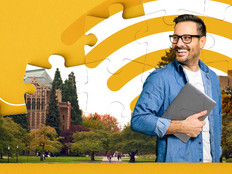The Tech Campuses Need for Outdoor Wi-Fi
Before Millersville University brought students, faculty and staff back to its Pennsylvania campus, its IT department installed new wireless networks at several outdoor spaces, including MU’s pond and bus stops.
To ensure that students can take courses almost anywhere outside, the university invested in two Cisco access point technologies: the external antenna APs and wireless mesh.
The IT team also installed mesh antenna on taller buildings to give people wider Wi-Fi coverage outdoors. “Students can sit under a tree and still have good internet access,” Stephen diFilipo, MU’s CTO and chief innovation officer, tells EdTech.
Meanwhile, California Lutheran University has gotten creative with its wiring to boost internet strength in outdoor tent classrooms.
“Some of it is a little jury-rigged, with tying things off to a building and then draping it across a little corridor that now exists because of the tent structure,” Ryan Van Ommeren, associate vice president of facilities planning and operations at Cal Lutheran, tells University Business.
“This is part of an overall strategy of having a healthy environment on campus,” Van Ommeren says.
MORE ON EDTCH: Want to keep campuses safe from COVID-19? Protect the eyes.
The New Normal: Semipermanent Tent Classrooms with AV Tech
With no clear answer on when higher education institutions can return to normal, some colleges and universities view outdoor learning spaces as a long-term strategy for ensuring student and faculty satisfaction.
This is why Rice University in Houston has taken a more permanent approach with its outdoor classrooms. The university recently invested in a number of open-sided tents and semipermanent tents equipped with AV technology.
Although the semipermanent tents are enclosed spaces, which means they are not as safe as regular tents, they help the university create small, socially distanced classes and meeting spaces.
These could be smart investments even after the pandemic ends. After all, isn’t it nice to take classes outside on nice days? Outdoor classrooms are likely to remain a selling point for prospective students long after the risk of COVID-19 has passed.
This article is part of EdTech: Focus on Higher Education’s UniversITy blog series.











